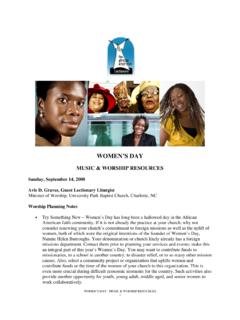Transcription of Providing health care - who.int
1 82 CHAPTER 10 Providing health careIn any community, people become ill and require access to health care facili-ties and treatment. The problem may be physical, such as diarrhoea, fever orinjury, or mental, psychosis, epilepsy or a learning difficulty. Women havespecial needs related to pregnancy and childbirth, and children requireimmunization against common diseases. Regardless of the nature of thehealth issue, the health outcomes depend to a large degree on individuals ability to access health care services. Unfortunately, health services are oftenplanned without consulting the community members who use and pay forsuch services, particularly in rural areas. To counter this, and to meet com-munity demands for accessible, affordable services, community membersshould be actively involved in their planning.
2 health centres should attractthe community (see Figure ).The way in which people deal with illness is also an important factor inhealth care. Most people initially treat ill- health within the home and seekoutside help only when the problem continues or becomes severe. Such helpmay not necessarily come from qualified medical personnel; it can also comefrom local pharmacists or medicine sellers, traditional healers, religiousleaders and friends. Often, seeking medical advice from qualified personnelis the last resort. This can happen for many reasons, such as that an individ-ual does not consider the problem to be severe or medical in nature, or thatthe value of medical advice is not appreciated.
3 Sometimes, there is simplymistrust of the medical , when planning health care interventions, it is importantfirst to understand current health practices, as well as community needs:which health care services are available, what type of service the communitywants and where health facilities should be located. This can be achievedthrough community discussions using participatory learning techniques withdifferent community groups defined by age, gender, wealth and ethnic/reli-gious affiliation. The purpose is to generate a reliable picture of communityneeds and ensure that the services provided will be equitable, accessible health care services health care facilities (rural clinics, health centres) should be within easy walkingdistance of the community, particularly for women and children.
4 Outreach or primary health care workers, such as health visitors and pro-moters, can be valuable front-line community health workers if they are providedwith adequate training and support, particularly if they come from the communityitself. Other health service providers (pharmacists, medicine sellers, traditional healers)can provide additional health advice and care if they are given adequate trainingand support, and are supervised by medical staff. Referral systems between different levels of health care (primary, secondary andtertiary) should be clear and comprehensible to both users and providers. Thereasons for referrals are often unclear to the users, which can provoke anxiety andlead to non-attendance.
5 In addition, many primary- and secondary-level healthcare workers may not understand how to refer a patient to higher levels of service,or may not recognize symptoms of more severe illness, which leads to dangerousdelays in 10. Providing health CARE83 Figure health community health care programmesWhen community health care services are established, it is essential that theprimary health care be effective and efficient. Community members can lobbylocal service providers to put primary health care workers in the community,as well as identify community members who could be trained to providehealth advice. Other people who can provide health advice to the commu-nity, such as pharmacists or medicine sellers, birth attendants and traditionalhealers, should also be identified.
6 Local service providers can be lobbied toprovide additional training and support for these people if necessary. To beeffective, health care workers should be acceptable to different communitygroups and have unrestricted access to the population. Women, for example,may not consider male health care workers to be acceptable for certain issues,and vice versa. Primary health care workers should also have sufficientknowledge and support to recognize illnesses that are beyond their ability totreat, and be able to refer patients to higher-level health care facilities forexpert advice and role of pharmacists and medicine sellers in malaria treatmentIn south Asia, WHO has promoted the use of local pharmacists and medicine sellersto provide treatment for malaria.
7 They have been trained to recognize malaria symp-toms, to prescribe the correct drug dosages, and to advise patients on whether theyshould seek expert advice. The programme has proved popular with communities,and with the medicine sellers and pharmacists, and it has reduced the burden onover-stretched health following questionnaire can help community members to determinewhether current health services are adequate. If the community lacks ade-quate access to health services, a strategy for improving the services shouldbe developed and presented to local service providers. Presenting a concreteplan for improving health services, rather than simply complaining that theyare inadequate, will enable service providers to plan the necessary current health services adequate?
8 Where is the nearest health centre to the community? Can women and childrenwalk to it within one hour? Do trained health workers visit the community? What treatment and health advicecan they offer?84 HEALTHY VILLAGES: A GUIDE FOR COMMUNITIES AND COMMUNITY health WORKERS Do health workers provide health education by visiting households and schools, orby attending community meetings? Is there a pharmacist or medicine seller in the community or in a nearby com-munity? What medicines can be obtained and what advice is provided? Do thepharmacists or medicine sellers receive supervision or support? Do communitymembers consider them to be helpful in treating disease? If community members become sick, do they have access to drugs and other treatments?
9 What sort of health service provision would the community like to have? that influence the type of health care that people seekWhen people are sick many cultural and societal factors influence whetherand where they seek health care and from whom. For example, it may be dif-ficult for women to approach male health workers for certain problems. Onthe other hand, individuals in the community who are perceived as wise, orlikely to have the required information, may be trusted by most communitymembers. Too often, traditional ways of treating health problems are dis-counted by people outside a community who try to impose western ororthodox models of health care, with their emphasis on medication.
10 However,if the illness is ascribed to angry gods or bad spirits, for example, thisapproach may not be perceived as effective and community members will beunlikely to seek orthodox health care; indigenous healers or religious leadersmay be consulted societal context of a disease, too, can affect whether people seekmedical advice. In communities where communicable diseases are common,diarrhoea may not be viewed as a major problem unless it is severe. Frequentmild cases of malaria may not lead the sufferer to seek medical assistance,even though malaria can be a life-threatening disease. As a result, peopleoften do not seek treatment and continue to have poor many reasons, therefore, it is important to work with a community tofind out where individuals go for health advice and why.















